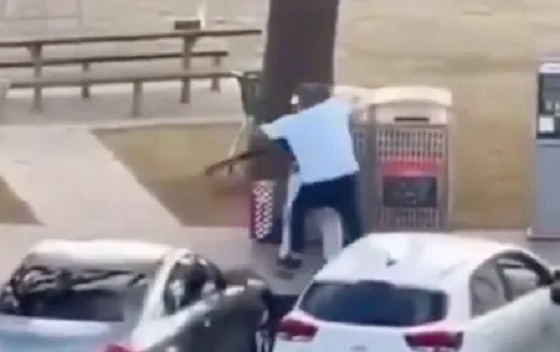Crime
Red Deer RCMP lay 34 charges in stolen vehicle operation

Red Deer, Alberta – Red Deer RCMP arrested 13 people, executed 34 outstanding warrants and laid 34 new criminal charges on eight people in a four-day covert stolen vehicle operation last week that also netted a sawed off rifle, various drugs and stolen property.
The covert operation took place from December 5th to 8th in Red Deer and area and involved police officers from the Red Deer RCMP Community Response Unit (CRU), GIS and general duty, the RCMP Emergency Response Team (ERT), Blackfalds RCMP and Police Dog Services. Covert strategies were used to avoid the public safety risks created by criminals driving dangerously or ramming police vehicles in their efforts to avoid arrest. RCMP recovered 11 stolen vehicles during the operation and continue to investigate regarding other recovered stolen property.
“While we aren’t going to divulge our methods of locating and tracking criminals in stolen vehicles in order to arrest them without harm to the public or to our police officers, I will say that our community – and the prolific criminals within it – can expect to hear about more of these types of operations,” says Inspector Gerald Grobmeier of the Red Deer RCMP. “Red Deer RCMP continue to aggressively apply pressure to habitual offenders through a wide range of targeted, evidence-based crime reduction strategies. This approach is how we police in Red Deer every day.
Arrests and charges during the operation include:
· 22 year old Reanne Brodersen faces six new criminal charges after being arrested in a stolen Ford Focus in possession of fentanyl, methamphetamine and heroin. She is scheduled to appear in court on December 23 at 9:30 am.
· 33 year old Jeremy John Terpstra was arrested in a stolen car that had been left unlocked and running on December 6. He faces three new criminal charges and his trial is scheduled for March 15, 2018.
· 27 year old Christoperh Suderman and 28 year old Shanelle Cardinal were arrested at a hotel in possession of a stolen vehicle. Suderman was wanted on 15 outstanding warrants and now faces two new criminal charges; he is scheduled to appear in court on December 20 at 9:30 am. Cardinal was wanted on 11 outstanding warrants at the time of her arrest.
· Four people were arrested in a Ford Escape that had been stolen out of Red Deer when it was left unlocked and running. 37 year old Jeremy Daniel Hiebert was arrested with a sawed off rifle next to the driver’s seat and faces 11 new criminal charges; he is scheduled to appear in court on January 4, 2018 at 9:30 am. 22 year old Brianna Carroll was arrested on eight outstanding warrants and charged with failing to comply with court-imposed conditions; she is scheduled to appear in court on December 22 at 8:30 am. 32 year old Rory Forslund faces a charge for obstructing/ resisting a peace officer; he is scheduled to appear in court on January 24, 2018 at 9:30 am.
· 45 year old Wessam Ziab Haimour faces two criminal charges after being arrested in a stolen Toyota Corolla in possession of cocaine; he is scheduled to go to trial on March 16, 2018.
· 29 year old Gregory Deering was located in a stolen vehicle while parked in a handicapped parking space at a gas station. At the time of his arrest he was in possession of bear spray in contravention of court imposed conditions. He faces six criminal charges and a traffic charge for illegally parking in a handicapped spot; he is scheduled to appear in court on December 20 at 9:30 am.
· RCMP also arrested a 34 year old man for impaired driving – not in a stolen vehicle – after he drove over a median in front of police officers who were taking part in the covert operation.
Crime
Hero bystander disarms shooter in Australian terror attack

Insane footage shows a bystander attacking and disarming one of the terrorists, who appears to have been armed with a long rifle, during today’s shooting attack on an event celebrating Hanukkah at Bondi Beach in Sydney, Australia. pic.twitter.com/mJceco22bJ
— OSINTdefender (@sentdefender) December 14, 2025
The chaos that struck Australia on Sunday night produced one moment of astonishing courage: a Sydney shopkeeper, armed with nothing but instinct and grit, charged a gunman at Bondi Beach and wrestled the rifle out of his hands as terrified families ran for cover. Authorities say the act likely prevented even more deaths in what officials have already called an antisemitic terror attack that left 12 people dead and dozens wounded during a Hanukkah celebration along the water.
The hero has been identified as 43-year-old fruit shop owner Ahmed Al Ahmed, a father of two who happened to be nearby when gunfire erupted at the beachfront event “Hanukkah by the Sea,” which had drawn more than 200 people. Footage captured the moment he marched toward the shooter, grabbed hold of the rifle, and overpowered him in a brief, violent struggle. As the gunman hit the pavement, Al Ahmed momentarily pointed the weapon back at him but didn’t fire, instead placing it against a tree before another attacker opened up from a bridge above. He was hit in the hand and shoulder and is now recovering after emergency surgery.
A relative told Australia’s Channel Seven that Al Ahmed had never handled a gun in his life. “He’s a hero — he’s 100 percent a hero,” the family member said. New South Wales Premier Chris Minns echoed the praise, calling the scene “unbelievable,” adding, “A man walked up to someone who had just fired on the community and single-handedly disarmed him. Many people are alive tonight because of his bravery.”
Police say two shooters stepped out of a vehicle along Campbell Parade around 6:40 p.m. and began firing toward the beach. One gunman was killed, the other is in custody in critical condition. Detectives are also investigating whether a third attacker was involved, and bomb units swept the area after reports that an explosive device may have been planted beneath a pedestrian bridge. The toll is staggering: 12 dead, including one shooter, and at least 29 wounded — among them children and two police officers.
Prime Minister Anthony Albanese condemned what he called “a targeted attack on Jewish Australians on the first day of Hanukkah,” saying, “What should have been a night of joy and peace has been shattered by this horrifying evil attack.” Emergency crews flooded the beach as hundreds of panicked people sprinted away from the gunfire. Video shows one attacker firing down toward the sand from the bridge behind Bondi Park before being shot himself in a final standoff captured by drone footage. Both gunmen appeared to be carrying ammunition belts, with witnesses estimating up to 50 rounds were fired.
Australian police have cordoned off properties linked to the suspects and continue to canvass Bondi for additional threats. What remains clear is that Sunday’s attack was met with extraordinary acts of self-sacrifice, none more dramatic than a shopkeeper from Sutherland who walked into gunfire to stop further slaughter.
Crime
Terror in Australia: 12 killed after gunmen open fire on Hanukkah celebration

One of the suspected gunmen of the Bondi Beach massacre shooting in Australia has been identified as Naveed Akram
What was supposed to be a peaceful Sunday evening celebration of Hanukkah on one of the world’s most famous beaches instead descended into chaos and bloodshed, as two attackers opened fire on crowds gathered at Sydney’s Bondi Beach, killing 12 people — including one of the gunmen — and injuring at least 11 others.
The violence erupted shortly after 5 p.m. local time, just as more than a thousand people were gathering for “Hanukkah by the Sea,” an annual event held near a playground at the Bondi foreshore. According to Australian outlets, the shooting began as families were lighting candles and singing, sending parents scrambling to shield children and worshippers diving for cover along the promenade.
New South Wales Premier Chris Minns confirmed late Sunday that one attacker was killed at the scene and a second was arrested. He said the evidence already points unmistakably toward an anti-Jewish terror attack. “What should have been a night of peace and joy was shattered by a horrifying, evil attack,” Minns told reporters, noting investigators believe the plot was “designed to target Sydney’s Jewish community.”
NSW Police Commissioner Mal Lanyon said well over a thousand people were present when the shooting started, including two state police officers who were among those struck by gunfire, according to ABC News. Police also located what appeared to be an improvised explosive device in the vicinity shortly after the initial gunfire. Bomb technicians neutralized the device while officers locked down the area and urged residents to shelter in place.
Around 9 p.m., with ambulances and tactical units pouring in, authorities described the unfolding chaos as a “developing incident” and warned anyone nearby to stay indoors. Multiple victims were treated on the sand and the surrounding walkways before being rushed to hospitals across Sydney.
As investigators piece together the attackers’ movements and motive, officials say the toll could have been even worse given the size of the crowd and the presence of children throughout the event. What remains is a shaken city, a grieving Jewish community, and a country once again confronting the threat of political and religious extremism on its own soil.
-

 Focal Points2 days ago
Focal Points2 days agoCommon Vaccines Linked to 38-50% Increased Risk of Dementia and Alzheimer’s
-

 Automotive1 day ago
Automotive1 day agoThe $50 Billion Question: EVs Never Delivered What Ottawa Promised
-

 Alberta18 hours ago
Alberta18 hours agoAlberta introducing three “all-season resort areas” to provide more summer activities in Alberta’s mountain parks
-

 Health2 days ago
Health2 days agoThe Data That Doesn’t Exist
-

 Business1 day ago
Business1 day agoStorm clouds of uncertainty as BC courts deal another blow to industry and investment
-

 Agriculture17 hours ago
Agriculture17 hours agoGrowing Alberta’s fresh food future
-

 Business2 days ago
Business2 days agoThe Climate-Risk Industrial Complex and the Manufactured Insurance Crisis
-

 International16 hours ago
International16 hours agoTrump admin wants to help Canadian woman rethink euthanasia, Glenn Beck says





